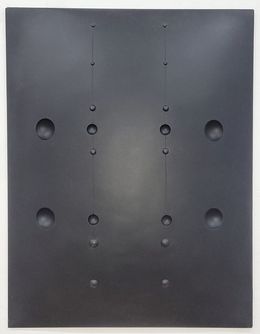
Presentation
Metal seems to be Kamiya's breadcrumb trail. Indeed, after training as a sculptor in his country of origin, our artist trained in 1976 at the National School of Arts and Crafts, metal section. It is the metal that brings him to sculpture and not the sculpture that leads him to work with metal. In this we find in Kamiya all the original ambiguity that resides in the position of those who are called artists – this indefinite frontier in perpetual motion, like a game of escape or dialogue with the craftsman. Looking closely at Kamiya's work and especially the way in which he describes it, we turn, turn around and find the notions of assembly and superposition, since this is how he prefers to define his works, referring them to single plastic action and their programmatic dimension. We could even go further by summoning that of DIY in the noble sense of the term.
Indeed, one finds in his artist's studio in Palaiseau plywood sheets, lead rolls, pliers, machines, welding and cutting tools, an oxygen bottle, etc., next to a small shelf of varnishes and inks. In short, a universe that invokes our imagination of the craftsman, the handyman more than that of the painter – and then after all why not? By giving a central place to assemblage in his work, the Japanese artist replays the signifier/signified relationship. It comes to question our relationship to the sign, to language. He superimposes simple elements, in a non-referential register: plastic half-spheres, rectangles or squares of painted lead, geometric figures in ink, etc. But it is in the assembly, the tinkering, the superimposition of these “insignificants" that the magic operates. There is a simple appearance of the object and a (surmountable) complexity of the gaze to unravel the sequential layering of the assemblage.
This organization becomes self-referential and modular, it has a link with minimalism. But Kamiya's wall sculptures are ultimately not only textures, colors, reliefs. Solids and voids play with light and the moment in an aesthetic of presentation and autonomous work. By referring to the string of plastic operations, therefore also concretely to the unity of duration, to the present time which contains the past and the future, his works go beyond modern de-subjectivation. He shows us purely through his plastic language, the photograph of a fragment of a pond in Japan. On the surface, we recognize the first dead leaves of the season, those of last autumn which are still floating, and others too, darker, almost black, which date back to bygone years. In the depths of the clear water, the sedimentation of even older leaves can be glimpsed, while the surface reflects the tall, verdant trees. The Superpositions of Kamiya, close to Shintoism, propose a symbolic structure of this temporality where crystallize, in a single place, the past, the present and the after. On another level, each of his works, dated, also continues to be superimposed on previous works and to relate to the work to come. Renewing his work, the artist offers us today in this exhibition to go beyond, even to reverse his universe essentially composed of black - kingdom of shadows and light - to come in parallel to explore white in all its nuances, as a new territory, a new look at its blends.

Discover our selections of works by artists
What are their 3 main works?
When was Takahisa Kamiya born?
